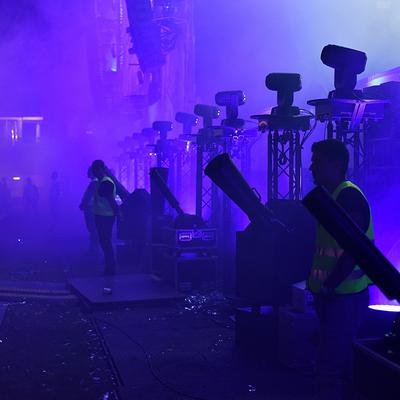MARTYN’S LAW: Essential Resources for Venues and Event Organisers

After years of campaigning, the Terrorism (Protection of Premises) Bill, also known as Martyn's Law, has received Royal Assent on 3 April 2025. This means that certain venues and events must be prepared to deal with potential terrorist threats. Are you ready to keep your events safe?
Tomorrow marks the eighth anniversary of the Manchester Terror Attack. As we remember the victims of this tragic incident, this year there is comfort in knowing that events in the UK will now be safer, as the Terrorism (Protection of Premises) Bill, also known as Martyn's Law, has become reality for venues and event organisers on 3 April, with an implementation period of 24 months.
Understanding Martyn’s Law
The legislation is the result of tireless campaigning by Figen Murray OBE, mother of Martyn Hett, one of 22 people killed in the 2017 Manchester Arena bombing on 22 May 2017. Since 2019 Ms Murray has been working with a team of co-campaigners to advocate for venues and event organisers to take legal responsibility to keep events safe. This includes preparedness for terrorist attacks and practical actions to reduce the risk of physical harm and impact of an attack.
For those responsible for events, whether at a conference centre, theatre, or temporary festival, understanding the law and accessing the right support is crucial for compliance and, more importantly, for keeping people safe.
Here’s a guide to the key resources, organisations and practical steps to help venues and event organisers navigate Martyn’s Law.
Martyn’s Law: What’s Required?
Martyn’s Law introduces new, tiered requirements for venues and events based on capacity.
Venues expected to host 200-799 people fall under the ‘Standard Tier’. The requirements in this tier are centred on simple, low-cost activities designed to ensure those working at premises or events are better able to reduce harm, and save lives, in the event of an attack. They could be as simple as locking doors, closing shutters, and identifying safe routes to safety.
If 800 or more individuals may be present at your event or venue, it will be in the ‘Enhanced Tier’. You are additionally required to assess terrorism risks, implement proportionate protective measures to reduce vulnerability and physical harm in the event of an attack, and document the measures in place. These could include bag search policies, CCTV surveillance and vehicle checks.
The law applies to a wide range of premises, including entertainment venues, conference centres and temporary events.
The Security Industry Authority (SIA) will act as the regulator, providing statutory guidance and overseeing compliance, with a 24-month implementation period to allow venues and organisers to prepare.
Key Resources for Compliance
1. ProtectUK
ProtectUK is a platform backed by the Home Office and National Counter Terrorism Security Office (NaCTSO) to provide the latest guidance, resources, and eLearning on counter-terrorism preparedness for venues, event organisers and the public. The site offers:
- Up-to-date information on Martyn’s Law and related legislation
- Risk assessment and threat analysis tools
- Free guidance, campaign toolkits and eLearning resources such as the Action Counters Terrorism (ACT) e-learning
- Templates for security plans and checklists
ProtectUK is recommended by police and security experts as the first port of call for anyone seeking to understand and implement Martyn’s Law requirements.
2. Police Counter Terrorism Security Advisers (CTSAs)
Local police forces have dedicated CTSAs who can offer security advice to venues and event organisers. CTSAs have comprehensive, specialist training in areas including site and vulnerable point surveying; explosives; pathogens and toxins; radiological sources; business continuity and disaster recovery; chemical, biological, radioactive or nuclear (CBRN) defence, among others.
3. Project Servator
Project Servator is a policing tactic that aims to disrupt a range of criminal activity, including terrorism, while providing a reassuring presence for the public. Project Servator involves police carrying out highly visible and unpredictable deployments, such as uniformed police officers, dogs and horses, armed officers etc., and less visible ones, such a plain clothes officers, drones and CCTV, and are specially trained to spot attempts of hostile reconnaissance.
Event organisers and venues can work with local police to integrate elements of Project Servator into their security planning, providing reassurance to attendees and staff while deterring hostile activity.
They also provide a free training programme, See, Check and Notify (SCaN), that empowers businesses and organisations to correctly identify suspicious activity and know what to do when they encounter it.
3. Police Crime Prevention Academy (PCPA)
The PCPA is a not-for-profit organisation owned by the police that delivers accredited training and guidance on counter-terrorism and public safety. They are developing eLearning specifically for Martyn’s Law, designed to help venues and organisers understand their obligations and implement practical measures.
4. Industry Associations and Guidance
Industry bodies such as the Association of Event Venues (AEV), Association of Event Organisers (AEO), industry guidelines such as the Purple Guide (targeting outdoor events), and public-private partnerships such as Pool Reinsurance who serve 90% of the UK terrorism property insurance market, offer sector-specific advice, case studies, and forums for sharing best practice.
Practical Steps
- Conduct a terrorism risk assessment using ProtectUK guidance or with the support of a CTSA.
- Develop and document emergency procedures (evacuation, lockdown, invacuation, communications).
- Train staff and volunteers using ProtectUK eLearning and PCPA resources.
- Engage with local police to explore Project Servator support and regular security reviews.
- Keep up to date with statutory guidance from the SIA and sector-specific updates from industry associations.
- Test and review plans regularly, using scenario-based exercises and digital tools where appropriate.
Harrogate Convention Centre: A Secure Partner for Safe Events
Choosing the right venue is a crucial part of making your event safe. Venues such as Harrogate Convention Centre exemplify best practice in event security and public safety. We work closely with local and national security bodies, regularly reviewing and updating protocols to align with the latest government guidance and Martyn’s Law requirements. Measures in place include:
- Bag searches and restricted items policies for public events
- Comprehensive CCTV surveillance
- Collaboration with police and counter-terrorism advisers
- Ongoing staff training and scenario planning
- Clear communication with organisers and attendees about security protocols
Harrogate’s state-of-the-art facilities, combined with its proactive approach to safety, make it a trusted venue for organisers seeking reassurance and support in meeting their legal obligations and keeping attendees safe. By choosing a venue with a proven commitment to security, organisers can focus on delivering successful events, confident that robust protective measures are in place.
Conclusion
Martyn’s Law marks a significant shift in the responsibilities of event organisers and venues across the UK. By leveraging resources such as ProtectUK, working with police and counter-terrorism experts, and choosing secure venues like Harrogate Convention Centre, organisers can not only comply with the law but also create safer, more resilient events for everyone.
Now is the time to act—engage with these resources, start planning, and make public safety a central pillar of your event strategy.
Our latest blog posts

Giving Back: How Harrogate Convention Centre helps Yorkshire Air Ambulance save lives
Discover how HCC supports Yorkshire Air Ambulance via event-based fundraising, showcasing its commitment to ESG and community impact.

Surge in medical conferences highlights Harrogate’s growing appeal as unique conference destination
Medical conferences held at Harrogate Convention Centre in 2024/25 topped the past decade and more than doubled that of the previous year.

MARTYN’S LAW: Essential Resources for Venues and Event Organisers
The Terrorism (Protection of Premises) Bill, aka Martyn's Law, is now written into law. Are you ready to keep your events safe?
Why Choose Harrogate
MoreEvent Services
Your event, our expertise
From high-profile conferences and major industry exhibitions to glittering banquets and world-class live shows.
More
